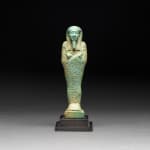Egyptian Green-Glazed Terracotta Ushabti of General Ankhwaibra-Saneith, 6 Century BCE
Terracotta
height 16.5 cm
height 6 1/2 in
height 6 1/2 in
X.0307
Perhaps no single object epitomizes the spirit of Ancient Egypt better than the ushabti. Shaped like a divine mummy, the ushabti evokes the magical side of the Egyptian belief in...
Perhaps no single object epitomizes the spirit of Ancient Egypt better than the ushabti. Shaped like a divine mummy, the ushabti evokes the magical side of the Egyptian belief in an afterlife, while the pick and hoes clutched in the hands, as well as the seed bag slung over his shoulder, recall the rural, agrarian culture of the land. The word ushabti (supplanting the older term shawabti) literally means “the answerer.” The function of these figures is described in Chapter 6 of the Book of the Dead: “O this Ushabti! If (the deceased) is called upon to do hard labor in the hereafter, say thou: I am here.” The ushabti was expected to answer the call to work in place of the deceased, and this passage was frequently inscribed on the figures themselves. Originally, a single ushabti was placed in a given tomb; but by the New Kingdom, the statues had come to be regarded as servants and slaves for the deceased rather than as a substitute, and many might be found buried together, along with a larger overseer figure.
In the course of Egyptian history, ushabti were created from wood, stone, metal, and faience. In the cultural renaissance of the 26th Dynasty, also known as the Saite Period (the time when this work was produced), a green glaze, the color of the Nile and evocative of the verdant landscape in springtime, was particularly popular. The ushabti bears nine horizontal lines of hieroglyphic inscriptions on the front and column of hieroglyphs on the reverse. Such inscriptions generally offer prayers from the deceased and reveal the ushabti’s readiness to perform labor. Additionally, the text here reveals that this ushabti was placed in the tomb of General Ankhwaibra-Saneith, the son of Psamtek and Istemkhebi. To look upon this ushabti is to come face to face with the mystery and magic of Egypt itself.
In the course of Egyptian history, ushabti were created from wood, stone, metal, and faience. In the cultural renaissance of the 26th Dynasty, also known as the Saite Period (the time when this work was produced), a green glaze, the color of the Nile and evocative of the verdant landscape in springtime, was particularly popular. The ushabti bears nine horizontal lines of hieroglyphic inscriptions on the front and column of hieroglyphs on the reverse. Such inscriptions generally offer prayers from the deceased and reveal the ushabti’s readiness to perform labor. Additionally, the text here reveals that this ushabti was placed in the tomb of General Ankhwaibra-Saneith, the son of Psamtek and Istemkhebi. To look upon this ushabti is to come face to face with the mystery and magic of Egypt itself.



